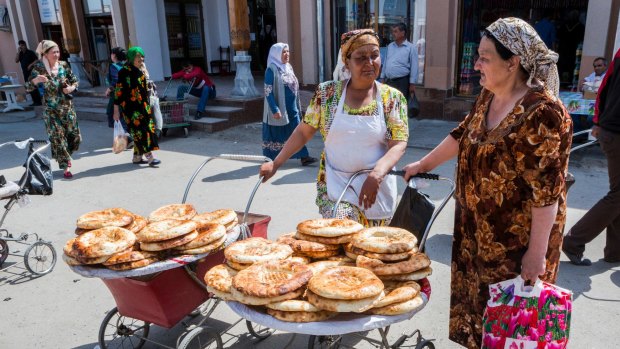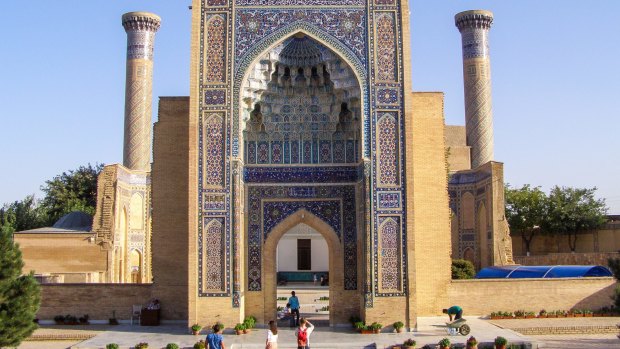This was published 5 years ago
Tamerlane's makeover: Uzbekistan's legends are not quite what they seem
By Ben Groundwater

Samarkand is a bustling and modern city where ethnic Tajiks wear brightly coloured traditional clothes.Credit: Alamy
Forty-five metres is a long way to fall. That's about the height of a 15-storey building. It's the clearance of the Sydney Harbour Bridge. It's not going to end well.
Kalyan Minaret looks dizzyingly high from ground level, a brick tower that dwarfs the ancient city of Bukhara spread out below. It's busy here today, the hubbub of tourists and commuters always present, but if you concentrate hard enough you can almost hear the distant pleas for mercy from the doomed few.
This 45-metre minaret has been used for many things during its 900-year history – a watchtower during wartime; a place to call to prayer during peace – but its use as a site for public executions is perhaps the most fascinating, and disturbing.

Tamerlane's tomb in Samarkand, Uzbekistan.Credit: Alamy
"When did they do that?" I ask my guide, Shaknoza, as we squint into the beaming sun, trying to see all the way to the great minaret's highest point, the point from which dissidents were once thrown.
She shrugs. "It was stopped early in the 20th century."
That's… not so long ago. In fact, relative to Uzbekistan's long history it's the blink of an eye.
This shouldn't come as a surprise though, because the past is not always distant in this part of the world. Uzbekistan might be a nation with a history that stretches back thousands of years, that takes in powerful leaders such as Alexander the Great and Genghis Khan, that has played a part in so many empires and been the seat of its own, a major hub on the Silk Road and a bastion of Central Asian power – but it's very much alive today. Its legends are within arm's reach.
Here in Bukhara alone there are so many present-day reminders of what should be the long-distant past. They're visible in Kalyan Minaret, of course, the city's most recognisable landmark, a place with significance both religious and historical. They can be found, too, in the niches carved into the city's oldest buildings, where melted candles still sit, sure signs that Zoroastrianism, an ancient religion of fire that has officially been discarded by this Muslim-majority country, survives. They're inside the caravanserais too, the 1000-year-old Silk Road-era hotels that you find are still in use today, that now house tourist shops and markets.
The past lives on throughout this entire country, though it's constantly being reshaped, regularly being massaged to fit the modern day.
In Samarkand, another Silk Road hub that's thousands of years old, history is closer than you realise. This is the former seat of the Timurid Empire, a vast holding of people and land that, at the height of its power in the 14th century, took in not only modern-day Uzbekistan but much of Central Asia, as well as parts of Iran, India, Pakistan, Syria and Turkey. It was amassed and ruled by a terrifying Uzbek leader, Amir Timur, a ruthless pillager in the Genghis Khan mould, a man thought to be responsible for the death of some 17 million people.
Timur, known to the Uzbeks by the single moniker Tamerlane, has been a subject of fear and even shame for local people in the past. The ruler was cast as a historical villain, a mass murderer best forgotten under the rule of the Soviets, who preferred Lenin and Stalin as figures of worship. Upon Uzbekistan's independence, however, a local hero was needed, and a nation turned its lonely eyes to Tamerlane. The legend was born.
Tamerlane's final resting place is in Samarkand, a bustling and modern city that still bears the hallmarks of its powerful past, in the grandeur of the tiled madrassahs at Registan Square, and in the beautifully decorated mosques and mausoleums that still dominate the city's skyline. Ethnic Tajiks wander Samarkand in their brightly coloured traditional clothes; the Siab Bazaar is a sprawling marketplace that's barely changed in millennia.
Tamerlane's tomb is one of the city's most impressive structures, a domed building that was left to ruin by the Soviets but has since been restored as a major tourist attraction, and a place I soon find myself joining the crowds to visit.
Here, once again, the past is not quite what it seems. The mausoleum might be old – it's a magnificent 600-year-old building with interior walls covered in gold leaf and a high dome tiled by the ancient Persians – but the figure who stares down from the wall is not.
"He's good-looking, isn't he?" says my guide here, Ruslan, motioning towards a portrait of Tamerlane. I agree. He's broad-shouldered and brooding, with a close-cropped beard and piercing eyes.
This is the classic image of the Uzbeks' great leader, one seen across the country, and it was created, it turns out, not in ancient times, but about 30 years ago. A local artist was tasked with fashioning an image of a national hero that would be acceptable to the masses. Thus, the slight and permanently disabled Amir Timur of history became the strapping, attractive Tamerlane now seen across the country.
Legends are built up in Uzbekistan, and they're cast down. Ancient structures are repurposed or rebuilt. Beliefs are moulded around new deities and ideas. The past is a living thing.
In Tashkent, the country's capital, it's not so much the Silk Road era that's noticeable, nor the power and the might of Tamerlane, but the far more recent rule of the Soviet Union on display. The Russians have gone, handing the reins to an independent nation in 1991, but their influence remains.
You can't miss it in Tashkent's metro stations, Soviet-era transport hubs that are lavishly decorated in the Russian style, uniquely themed to reflect their location within the city. It's there in the USSR-era Hotel Uzbekistan, a spectacular, brutalist tower that dominates the skyline. It's in the language too, though most people here speak at least a few tongues, native languages like Uzbek and Tajik, as well as Russian and some English.
Tashkent was also the seat of power for a fearsome leader, though one whose history is far more recent than Tamerlane's. Islam Karimov was the modern country's first president, an iron-fisted ruler who was in power for 25 years before eventually ceding his throne in 2016 the only way he was ever likely to: by dying.
His former palace, once a feared no-go zone for the Uzbek people, has recently been opened to the public, and its walls, I discover, feature a series of portraits of the president looking statesmanlike and benevolent, a caring leader for a fledgling nation. Perhaps Karimov's past will be massaged, too, I realise, another once-feared leader who will go on to be remembered as a hero.
At least he didn't throw anyone from the top of a minaret.
FIVE UNMISSABLE SIGHTS
KOSMONAVTLAR STATION, TASHKENT
The Soviet-era metro stations in the Uzbek capital are all works of art, each with a lavish and unique design. Perhaps the most interesting is Kosmonavtlar, a space-exploration-themed station dedicated to Uzbek cosmonaut Vladimir Dzhanibekov.
REGISTAN SQUARE, SAMARKAND
This central square is probably the most recognisable place in Central Asia, an open space framed on three sides by intricately tiled Persian-style madrassahs. The buildings are all open to the public, and it's possible to pay an additional fee to climb the minarets.
THE ARK, BUKHARA
Bukhara's oldest structure was the residence of the city's rulers for centuries, though these days it's open to the public. The Ark is a fascinating city-within-a-city, filled with museums, a mosque, a vast reception court, a treasury, and a few prison chambers with grisly histories.
GUR-E AMIR MAUSOLEUM, SAMARKAND
The burial chamber of Amir Timur, or Tamerlane, is as impressive for the design of the building itself – with its blue-tiled, fluted dome, its ornate archways, its gold-tiled tomb and solid jade sarcophagus – as for its significance to the Uzbek people.
BIBI-KHANYM MOSQUE, SAMARKAND
At time of construction, in the 15th century, Bibi-Khanym was one of the largest mosques in the world, a structure commissioned by the great leader Tamerlane. Extensive restoration work since Uzbekistan's independence means the mosque retains much of its former glory.
TRIP NOTES
MORE
FLY
Emirates flies in code share with Azerbaijan Airlines from Sydney to Tashkent, via Dubai and Baku. Call 1300 303 777 or see emirates.com
TOUR
Wendy Wu Tours operates private, eight-day "Heart of Uzbekistan" tours, priced from $2340 a person, twin share. The company also has a fully inclusive, 28-day group itinerary called "Road to Samarkand" that includes 10 days in Uzbekistan. Prices start from $10,480 a person. Call 1300 727 998, see wendywutours.com.au
Ben Groundwater was a guest of Wendy Wu Tours
Sign up for the Traveller Deals newsletter
Get exclusive travel deals delivered straight to your inbox. Sign up now.